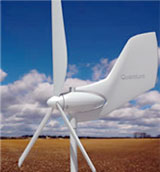
HAWT are the most common turbine used today widely. They consist of a tall tower, atop which sits a fan-like rotor that faces into or away from the wind, a generator and other components. Most horizontal axis turbines built today are mostly three blades.
HAWT sit high atop towers to take advantage of the stronger and less turbulent wind at 100 feet (30 meters) or more above ground and it may vary depends on the overall elevation of the location. Each blade acts like an airplane wing, so when wind blows, a pocket of low-pressure air forms on the downwind side of the blade. The low-pressure air pocket then pulls the blade toward it, which causes the rotor to turn. This is called lift. The force of the lift is actually much stronger than the wind’s force against the front side of the blade, which is called drag. The combination of lift and drag causes the rotor to spin like a propeller, and the turning shaft spins a generator to make electricity.
We at ONP has engineered various small and medium size HAWT for efficient energy production considering various factors of natural resources. We also build various shapes and designs for a client to choose from.
HAWT Product Specifications
| Model |
HT05A1 |
HT1A1 |
HT2A1 |
HT3A1 |
| Wind Turbine Rated Power (W) |
500 Watt |
1 KW |
2 KW |
3 KW |
| Wind Turbine Rated Voltage (V) |
12 / 24 |
12 / 24 |
24 / 48 |
48 / 96 |
| Rated Wind Speed |
3 m/s |
3 m/sc |
4 m/s |
4 m/s |
| Number of Blades |
3 |
3 |
3 |
3 |
| Blade Material * |
Refer * |
Refer * |
Refer * |
Refer * |
| Generator type |
PM** |
PM |
PM |
PM |
| Transmission |
Direct Drive |
Direct Drive |
Direct Drive |
Direct Drive |
| Cut-in Wind Speed |
2 m/s |
2 m/s |
2 m/s |
2.5 m/s |
| Cut-of Wind Speed |
25 m/s |
25 m/s |
25 m/s |
25 m/s |
| Rated Battery Voltage (V) |
12 / 24 |
12 / 24 |
12 / 24 |
12 / 24 |
| Suggest Battery |
12V 150AH 2nos |
12V 150AH 4nos |
12V 150AH 8nos |
12V 150AH 16nos |
* Blade Material: Options are Aluminium, Stainless Steel, Reinforced Fiber Glass.
** Pemanent Magnet.
HAWT Models